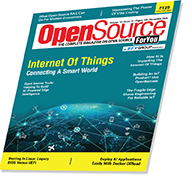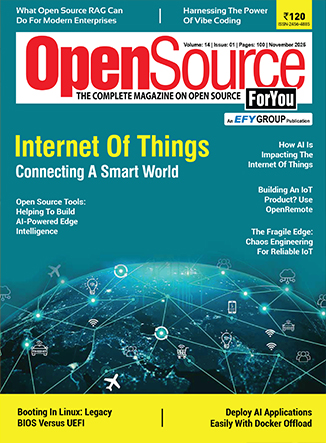|
OpenSource For You
December 2025 Issue
Vol. 14 No. 12
Focus
Cloud Cost Governance Using Kubecost, OpenCost, and Infracost
Explore how combining Kubecost, OpenCost, and Infracost into a unified workflow can improve cloud cost management.
|

|
Focus
When AI Meets DevOps to Build Self-Healing Systems
Traditional DevOps, with its rule-based automation, is struggling to work effectively in todayís complex tech world. But when combined with AIOps it can lead to IT systems that predict failures and solve issues without human intervention.
| Focus
Apache Iceberg and Trino: Powering Data Lakehouse Architecture
Apache Iceberg is a cornerstone of any open data lakehouse, providing the transactional foundation upon which highly scalable and flexible analytics can flourish. Along with Trino, it can be used to build a robust, scalable, and high-performance data lakehouse. |
| |
Focus
Grafana: The Comprehensive Monitoring Platform
This brief tutorial will help you to install and configure Grafana for your organisation.
| Focus
A Tutorial on Orchestration and Observability of Edge Inference via CI/CD Pipelines
The framework outlined here has been developed by the authors to deploy near realtime applications on heterogeneous edge clusters by addressing resource tuning, secure credentials, and decentralised monitoring. It includes the integration of CI/CD and orchestration best practices for edge environments, sensor-aware scheduling, and a comprehensive observability solution. | | |
Focus
Job Opportunities: Whatís Hot in the Cloud Space?
Companies will continue to hire developers with cloud expertise in 2026, provided they are continuously upgrading their skills in this domain and are experienced in open source software development.
| Focus
Deploying AI-Based Models? Use Hugging Face Spaces and Render
Hugging Face Spaces and Render are two key cloud platforms that support the development and deployment of AI-based models. Find out howÖ | | |
For U & Me - Overview
The Untold Story of UNIX
Curious about how and why UNIX was developed? Youíll find the answers here.
| For U & Me - InSight
The Role of Open Source in Building Modern Data Infrastructure
Itís no secret that open source is emerging as the backbone of modern data infrastructure. Hereís a list of the core open source technologies used to deploy this infrastructure, along with some real-world examples and a brief on why open source matters. | | |
For U & Me - Overview
IoT: Helping to Transform Healthcare
The Internet of Things is enabling faster emergency response times in the healthcare industry along with continuous and real-time monitoring of chronic diseases. Whatís more, itís enabling better healthcare services in remote areas.
| For U & Me - InSight
The Quest to Build a Quantum Computer
The road to large-scale quantum computing is long and hard, with incremental advances paving the way. But the destination is in sight. | | |
Open Source India 2025
Open Source India 2025: Showcasing the Ever-Growing Open Source Ecosystem in India
Hereís a visual snapshot of everything that went down last month in Bengaluru at Open Source India ó the flagship gathering for the open source community that includes industry leaders, developers, hackers, innovators, as well as tech giants and start-up organisations.
| Developers - How To
Securing Client Identity with Post-Quantum Cryptography
Hereís a quick tutorial on how to build a secure, real world client-server model that establishes client identity by using CRYSTALS-Dilithium, a postquantum cryptography algorithm. | | |
Developers - How To
How to Automate Java Code Modernisation
This short guide illustrates that automating Java code modernisation with Python and OpenAI API is not just possibleóitís remarkably effective.
| Developers - How To
Deploying Generative AI Models Efficiently
Enterprise deployment of generative AI hinges on the optimisation of hardware and software. Itís important to choose the right-sized language model and fine-tune it as per your need. | | |
Developers - Let's Try
Unlocking the Power of Multi-Agent Solutions with the Microsoft Agentic Framework
This comprehensive overview of the Microsoft Agentic Framework focuses on its latest features, practical implementation, real-world use cases, and the strategic benefits it brings to modern solution architecture.
| Developers - How To
SereneCare: A Secure, Full-Stack Healthcare Platform Built Using Open Source Tools
SereneCare, a healthcare management platform designed to bridge the gap between patients, doctors, and administrators, is focused on creating a unified, full-stack system that supports appointment scheduling, group consultations, health resource sharing, and rolebased workflows. Built entirely using open source technologies, SereneCare aims to offer a modular, scalable, and secure solution for modern healthcare challenges. | | |
Developers - InSight
Are AI Tools Making Software Development Easier?
How are AI tools like GitHub Co-pilot redefining software development by automating tasks, enhancing creativity, and fostering smarter humanmachine collaboration? Letís find outÖ
| Admin - How To
Setting Up Snort to Secure Your Network
Snort is a popular, open source intrusion detection system that monitors traffic in real time to detect malware. Hereís a detailed explanation of how to set it up on Ubuntu and test it by generating traffic from another system. | | |
Admin - Let's Try
OpenVAS: The Popular Vulnerability Assessment Tool
Hereís a comprehensive guide to how you can use OpenVAS to fix potential security issues before they crop up.
| Open Guru - Overview
The Whispering Machines: How Open Source is Bringing Intelligence to the Tiniest Devices
Built on open source frameworks, TinyML is enabling complex machine learning models to run on the microcontrollers embedded in connected devices, bringing artificial intelligence to the very edge of the network. | | |
|


